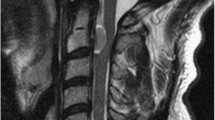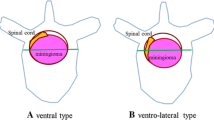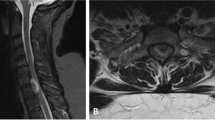Abstract
Background
Surgery for ventrally seated thoracic tumors requires an anatomically specific approach that is distinct from cervical or lumbar spinal cord surgery as the narrower spinal canal of the thoracic spinal cord makes it sensitive to surgical procedures. However, reports describing this operative technique are few. To obtain a wide operative field and minimize thoracic spinal cord retraction, we employed a posterolateral transpedicular approach in ventral-located tumors and investigated the efficacy and limitations of this technique.
Method
Eighteen patients with lesions (meningioma or neurinoma) located in the ventral intradural thoracic region were surgically treated between 2009 and 2014. The relationship among the clinical outcome, tumor location, and postoperative spinal alignment was analyzed.
Results
Postoperative neurological function improved in all patients, namely those with meningioma (p = 0.012) and schwannoma (p = 0.018). One patient who underwent removal of two facet joints suffered a postoperative compression fracture. Removal of two facet joints and pedicles resulted in a worsening of spinal alignment (p = 0.03), while this was not the case for the removal of one facet joint and pedicle (p = 0.72).
Conclusions
This case series clarified the benefits of the posterolateral transpedicular approach for resection of ventral intradural extramedullary tumors. Removal of one pedicle and facet joint seems to be more beneficial.



Similar content being viewed by others
References
Angevine PD, McCormic PC (2001) Retropleural thoracotomy. Technical note. Neurosurg Focus 10:1–5
Bauer R, Kerchbaumer F, Poisel S, Haelar A (1994) Transthoracic approach to thoracic spine. In: Bauer R, Kerchbaumer F, Poisel S (eds) Atlas of spinal operations. George Thieme Verlag, New York, pp 20–21
Blisky MH (2000) Transpedicular approach for thoracic disc herniations. Neurosurg Focus 9:3
Burke TG, Caputy AJ (2000) Treatment of thoracic disc herniation: evolution toward the minimally invasive thoracoscopic technique. Neurosurg Focus 9:1–7
Gelalis ID, Paschos NK, Pakos EE, Politis AN, Arnaoutoglou CM, Karageorgos AC, Ploumis A, Xenakis TA (2012) Accuracy of pedicle screw placement: a systemic review of prospective in vivo studies comparing free hand, fluoroscopy guidance and navigation technique. Eur Spine J 21:247–255
McCormick WE, Will SF, Benzel EC (2000) Surgery for thoracic disc disease. Complication avoidance: overview and management. Neurosurg Focus 9:13
Nagashima C (1973) Cervical myelopathy due to developmental stenosis of the cervical spinal canal, part 1. Neurol Surg 1:163–171
Nakagawa H (1986) Transthoracic approach and costtrasversectomy in the thoracic discogenic disease. No Shinkei Geka 14:1291–1296
Nakamura M, Fujiyoshi K, Tsuji O, Watanabe K, Tsuji T, Ishii K, Matsumoto M, Toyama Y, Chiba K (2011) Long-term surgical outcomes of idiopathic spinal cord herniation. J Orthop Sci 16:347–351
Nurick S (1972) The pathogenesis of the spinal cord disorder associated with cervical spondylosis. Brain 95:87–100
Nottmeier EW, Seemer W, Young PM (2009) Placement of thoracolumbar pedicle screws using three-dimensional image guidance: experience in a large patient cohort. J Neurosurg Spine 10:33–39
Patterson RH, Arbit E (1978) A surgical approach through the pedicle to protruded thoracic discs. J Neurosurg 48:768–772
Ransohoff J, Spencer F, Siew F, Gage L Jr (1969) Transthoracic removal of thoracic disc: report of three cases. J Neurosurg 31:459–461
Schwab F, Ungar B, Blondel B, Buchowski J, Coe J, Deinlein D, DeWald C, Mehdian H, Shaffrey C, Tribus C, Lafage V (2012) Scoliosis Research Society-Schwab adult spinal deformity classification: a validation study. Spine 37:1077–1082
Schwab F, Blondel B, Bess S, Hostin R, Shaffrey CI, Smith JS, Boachie-Adjei O, Burton DC, Akbarnia BA, Mundis GM, Ames CP, Kebaish K, Hart RA, Farcy JP, Lafage V (2013) International Spine Study Group (ISSG). Radiographical spinopelvic parameters and disability in the setting of adult spinal deformity: a prospective multicenter analysis. Spine 38:803–812
Simpson JM, Silveri CP, Simeone FA (1993) Thoracic disc herniation: re-evaluation of the posterior approach using modified costotransversectomy. Spine 18:1872–1877
Slin'ko EI, Al-Qashqish II (2004) Intradural ventral and ventrolateral tumors of the spinal cord: surgical treatment and results. Neurosurg Focus 17:1–8
Stillerman CB, Mcormic PC, Benzel EC (2004) Thoracic discectomy. In: Benzel EC (ed) Spine surgery: technique, complication avoidance, and management, 2nd edn. Elsevier, Philadelphia, pp 582–600
Takeuchi T, Abumi K, Shono Y, Oda I, Kaneda K (1999) Biomechanical role of the intervertebral disc and costovertebral joint in stability of the thoracic spine. A canine model study. Spine 24:1414–1420
Tomycz ND, Okonkwo DO (2011) Diagnosis and management of thoracic spine fractures. In: Winn HR (ed) Youman’s neurological surgery, 6th edn. Elsevier Saunders, Philadelphia, pp 3216–3232
Vaccaro AR, Silber JS (2001) Post-traumatic spinal deformity. Spine 26:S111–S118
Watanabe M, Chiba K, Matsumoto M, Maruiwa H, Fujimura Y, Toyama Y (2001) Surgical management of idiopathic spinal cord herniation: a review of nine cases treated by the enlargement of the dural defect. J Neurosurg 95:169–172
Acknowledgments
We thank Mr. S. Ono, Mr. M. Koinuma, Mr. T. Mimura, and Ms. E. Ayaka for their technical support during this study.
Author information
Authors and Affiliations
Corresponding author
Ethics declarations
Funding
Japan Society for the Promotion of Science (JSPS) provided financial support in the form of Grants-in Aid for Scientific Research: KAKENHI.
This work was supported by JSPS KAKENHI grant no. 15 K10356.
The sponsor had no role in the design or conduct of this research.
Conflicts of interest
None.
Ethical approval
All procedures performed in studies involving human participants were in accordance with the ethical standards of the institutional research committee and with the 1964 Helsinki Declaration and its later amendments or comparable ethical standards.
Informed consent
Informed consent was obtained from all individual participants included in the study.
Rights and permissions
About this article
Cite this article
Ito, K., Aoyama, T., Miyaoka, Y. et al. Surgery for ventral intradural thoracic spinal tumors with a posterolateral transpedicular approach. Acta Neurochir 158, 1563–1569 (2016). https://doi.org/10.1007/s00701-016-2864-7
Received:
Accepted:
Published:
Issue Date:
DOI: https://doi.org/10.1007/s00701-016-2864-7




